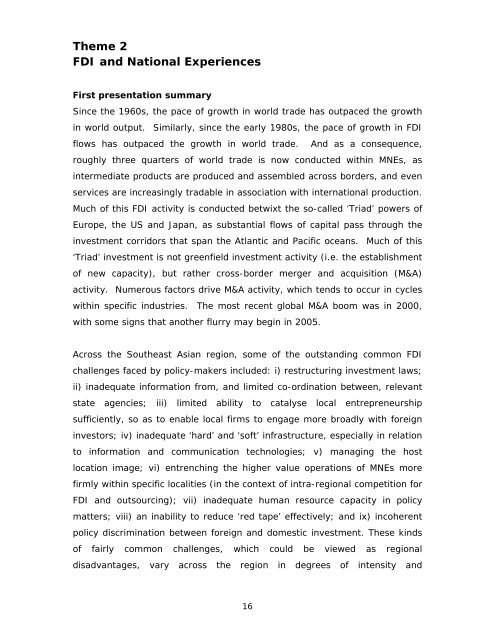(EGM) Foreign Direct Investment in Southeast Asia - Unido
(EGM) Foreign Direct Investment in Southeast Asia - Unido
(EGM) Foreign Direct Investment in Southeast Asia - Unido
Create successful ePaper yourself
Turn your PDF publications into a flip-book with our unique Google optimized e-Paper software.
Theme 2<br />
FDI and National Experiences<br />
First presentation summary<br />
S<strong>in</strong>ce the 1960s, the pace of growth <strong>in</strong> world trade has outpaced the growth<br />
<strong>in</strong> world output. Similarly, s<strong>in</strong>ce the early 1980s, the pace of growth <strong>in</strong> FDI<br />
flows has outpaced the growth <strong>in</strong> world trade. And as a consequence,<br />
roughly three quarters of world trade is now conducted with<strong>in</strong> MNEs, as<br />
<strong>in</strong>termediate products are produced and assembled across borders, and even<br />
services are <strong>in</strong>creas<strong>in</strong>gly tradable <strong>in</strong> association with <strong>in</strong>ternational production.<br />
Much of this FDI activity is conducted betwixt the so-called ‘Triad’ powers of<br />
Europe, the US and Japan, as substantial flows of capital pass through the<br />
<strong>in</strong>vestment corridors that span the Atlantic and Pacific oceans. Much of this<br />
‘Triad’ <strong>in</strong>vestment is not greenfield <strong>in</strong>vestment activity (i.e. the establishment<br />
of new capacity), but rather cross-border merger and acquisition (M&A)<br />
activity. Numerous factors drive M&A activity, which tends to occur <strong>in</strong> cycles<br />
with<strong>in</strong> specific <strong>in</strong>dustries. The most recent global M&A boom was <strong>in</strong> 2000,<br />
with some signs that another flurry may beg<strong>in</strong> <strong>in</strong> 2005.<br />
Across the <strong>Southeast</strong> <strong>Asia</strong>n region, some of the outstand<strong>in</strong>g common FDI<br />
challenges faced by policy-makers <strong>in</strong>cluded: i) restructur<strong>in</strong>g <strong>in</strong>vestment laws;<br />
ii) <strong>in</strong>adequate <strong>in</strong>formation from, and limited co-ord<strong>in</strong>ation between, relevant<br />
state agencies; iii) limited ability to catalyse local entrepreneurship<br />
sufficiently, so as to enable local firms to engage more broadly with foreign<br />
<strong>in</strong>vestors; iv) <strong>in</strong>adequate ‘hard’ and ‘soft’ <strong>in</strong>frastructure, especially <strong>in</strong> relation<br />
to <strong>in</strong>formation and communication technologies; v) manag<strong>in</strong>g the host<br />
location image; vi) entrench<strong>in</strong>g the higher value operations of MNEs more<br />
firmly with<strong>in</strong> specific localities (<strong>in</strong> the context of <strong>in</strong>tra-regional competition for<br />
FDI and outsourc<strong>in</strong>g); vii) <strong>in</strong>adequate human resource capacity <strong>in</strong> policy<br />
matters; viii) an <strong>in</strong>ability to reduce ‘red tape’ effectively; and ix) <strong>in</strong>coherent<br />
policy discrim<strong>in</strong>ation between foreign and domestic <strong>in</strong>vestment. These k<strong>in</strong>ds<br />
of fairly common challenges, which could be viewed as regional<br />
disadvantages, vary across the region <strong>in</strong> degrees of <strong>in</strong>tensity and<br />
16

















